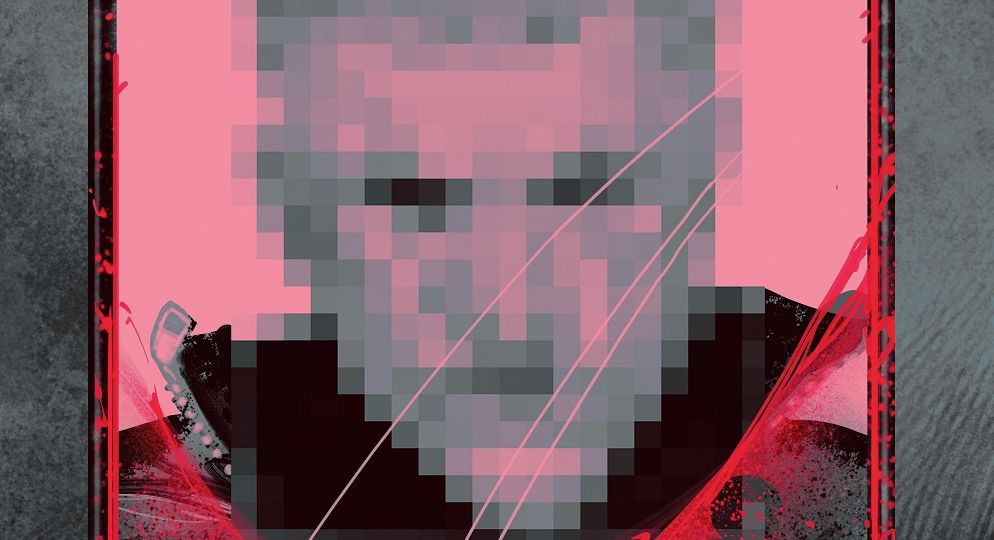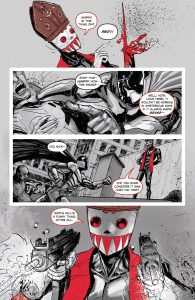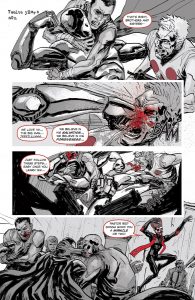
The cover for Bedlam #8 boasts the tagline “Is evil just something you are or something you do?” This in itself is an interesting question and makes an interesting point about the philosophical and physical natures of evil, but that will be addressed later in this review. Given the larger presence of villainy in the media this year (Chuck Klosterman’s latest book and the coming DC event book Forever Evil) it’s only fair that a question like this gets asked. As horrific and vile things continue to permeate our surroundings, are we as people naturally evil or do we just commit acts of evil? The same question gets asked of the protagonist, Fillmore Press, formerly the villain known as Madder Red.
Fillmore is a man who went into psychiatric care after “faking” (can it truly be considered faking when in essence he killed off the persona of Madder Red almost entirely?) his own death as Madder Red and has been allowed back into the world to walk a path of salvation so to speak. He even goes off on his own to help the police as an investigation consultant in order to atone for his crimes. It asks of us as readers (and as amateur philosophers) if we can truly be forgiven for committing crimes such as mass murder and thievery (although one of those two is substantially less villainous than the other given certain circumstances but I digress) or if we can forgive others for those crimes? There is no right or wrong answer to that question, but Bedlam seems to take the path that all can truly be forgiven if one follows a good path (if good is defined as going on the straight and narrow and helping others) and one does good deeds after their path of villainy is over.
Granted I may just be over-analyzing this (isn’t that the point?) but this is the sort of thing that deserves analyzing. In the canonical timeline of the earth, villains are construed as criminals who oppose the laws and inherent good will of man but not all of these villains are exactly evil. We label people like Eric Snowden and Julian Assange (to use more recent examples) as villains because they opposed the (obviously) unjust system the various political infrastructures had of spying on people and hiding secret documents. History will label them as villains because they exposed the tyrannically empirical reality behind programs we weren’t supposed to technically know about. Is it fair to label them as villains when all they did was expose (what might be sensitive) information about the dark underbelly of our leaders? I personally don’t believe it to be but, as said earlier, history will believe it because history is written by the winners, and the winners are the ones who are watching us.
It may seem totally wrong to compare a fictional killer in a comic book to real life people who only fought an Orwellian, post-1984 construction but when you have nothing left to compare a villain to except for other “villains”, what do you do?
Given that I’ve only been vaguely on topic in discussing the themes of Bedlam, I feel it is appropriate to get back to discussing the comic itself. The art is done quite well and has a scratchy, punk-rock filtered through proto-urban overtones. Ryan Browne does a magnificent job evoking Riley Rossmo’s style before he left the book (which I suppose in itself is a sort of backhanded compliment, praising Browne but also attacking him for not bringing a more unique style of his own to the book but what he does, he does extremely well). It really brings out the innate horror in the ongoing supernatural police investigation of the title. Nick Spencer is also creating a strong dialogue between Fillmore and the police detective he’s working with (whose name escapes me right now) and continues to develop both as a cooperatively dysfunctional team. What this does is keeps Fillmore’s mildly growing urges to go back to being Madder Red in check without anybody else knowing about it. Overall it’s a good story, yet it is just another stepping stone to the big climax in the current arc (although it hooks us up with an intriguing mystery).
The truly interesting thing about Bedlam is that it takes a semi-new look at the boundaries between good and evil (and if one can ever truly experience “salvation”) and the thin membrane that separates them. Nick Spencer is asking us if we can become “good” by throwing away the “evil” in our pasts and attempting to walk the path of righteousness. In a way, he subconsciously leads us to believe that we (and Fillmore Press) can atone for our mistakes (mass murder in this case) if we continue to do things we perceive as good and avoid confronting ourselves at all. The implications of that last part may or may not be a “good” thing depending on how you look at it.
So this brings us back to the question on the front cover of the book: Is evil just something you are or something you do?
The answer to that question is that evil can be both. Evil can be a very part of your nature (evil as in the way society views evil) and that you can naturally just be a gigantic asshole towards everyone and everything, or you can be an inherently good person who goes out and decides to commit an evil act (if you’re Catholic, drugs, alcohol, sex or masturbation might apply to the notion of that evil act) because you are curious to see if something as powerfully invigorating as stealing something might change your whole outlook on life. You can be a good person and choose to do evil things out of curiosity, or you can just be a naturally evil person who has a predisposition to hate everything. There is no black and white; there is only evil, and we fully embrace it.

















